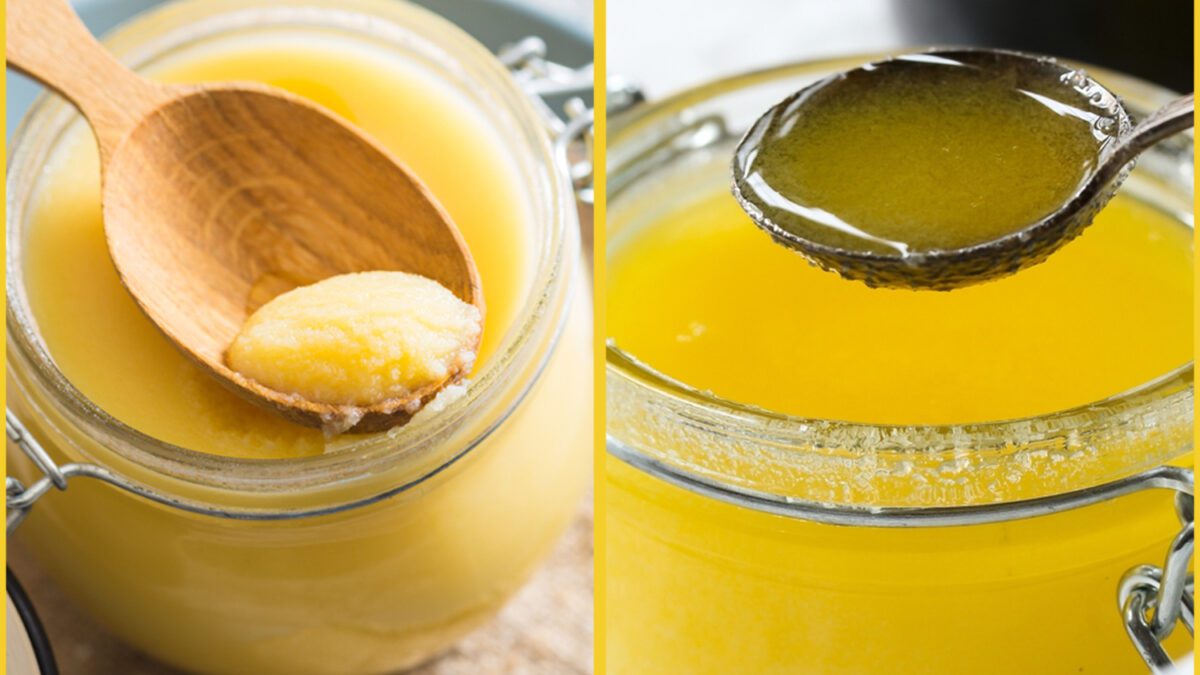
Looking beyond Malai ka Ghee
May 23, 2023
Top 5-factors to consider before buying the best milk
June 17, 2023Ghee Vs Clarified Butter – Are they both the same?
We often use Ghee and clarified butter interchangeably but are they the same? In simple terms, all ghee is clarified butter, but not all clarified butter is ghee. Are these two forms of butter the same, or is one better than the other? Let’s dive in to know more.
How are Ghee and clarified butter made?
Butter is simmered in a skillet over low heat to make clarified butter. As the water component of the butter evaporates, clumps of white milk solids form and begin to fall to the bottom of the pan. Sieve the contents through a mesh strainer lined with cloth into a heatproof basin or jar at this step. After straining off the milk solids, you’re left with clarified butter, sometimes referred to as “liquid gold”.
Ghee is prepared by simmering butter until the milk solids split and sinks to the bottom, producing a clear, golden liquid on top. After that, the liquid is filtered to eliminate any residual milk solids and water. The result is a rich, nutty flavour with a high smoke point, making it perfect for high-heat cooking, having a greater smoke point than butter, it will not burn when heated above a low temperature. It’s also a great source of healthy fats, including conjugated linoleic acid (CLA), which has been shown to have anti-inflammatory properties.
What are the key similarities?
Ghee and clarified butter are both forms of butter that have been heated and separated to remove water, milk solids, and impurities, leaving behind pure butterfat. As a result, they share many similarities:
Made from butter: Ghee and clarified butter are both made by heating butter until the water and milk solids separate from the pure butterfat.
Ideal for cooking: Because they are mostly pure fat, both ghee and clarified butter have a suitable smoke point, making them ideal for cooking at high temperatures.
Nutritional benefits: Ghee and clarified butter are high in fat-soluble vitamins like A, D, E, and K, which are necessary for numerous bodily processes. When consumed in moderation as an essential component of a balanced diet, they can provide achievable health benefits.
What are the key differences?
While both of them share similarities they have some essential differences as well
Production method: Both clarified butter and ghee are manufactured by separating the milk solids and water from butter, the methods of manufacturing differ slightly. Clarified butter is created by melting butter and skimming off the milk particles that rise to the surface. Ghee, on the other hand, is prepared by boiling butter until the milk solids separate and sink to the bottom, after which the clear liquid that is left is strained.
Enhanced flavour: Ghee has stronger colour and flavour than regular clarified butter. Clarified butter has a mild, buttery flavour, while ghee has a richer, nuttier flavour. This is due to the fact that ghee is cooked for a longer period of time, which caramelizes the milk solids and gives it a more complex flavour.
Shelf life: As the milk particles have been eliminated, ghee has a longer shelf life than clarified butter because there is less moisture in the finished product. This reduces the likelihood of spoilage and rancidity.
Smoke point: As stated earlier, Ghee has a higher smoke point than clarified butter, which means it can be heated to a higher temperature before it starts to smoke and burn. This makes it ideal for high-heat cooking methods like frying and sautéing.
Which one to choose?
In a literary piece published in the New York Times back in 1955, the legendary wordsmith R.K. Narayan rhapsodized about the pleasures of this golden elixir stating “Ghee is, no doubt, clarified butter,” Narayan wrote, “but it is also something more, in the same way, that wine is more than the juice of a squeezed grape.” Narayan’s words capture the essence of ghee’s allure, hinting at the richness and complexity that lies beneath its seemingly simple composition. Like wine, ghee’s flavour and aroma are the results of a delicate alchemy, a transformative process that elevates it from mere butter to something truly extraordinary. Although both are prepared by separating the milk solids and water from butter, ghee is heated for longer, giving it a more intense flavour and a higher smoke point. Clarified butter is ideal for cooking at low temperatures, but ghee is perfect for frying or sautéing at high heat. Ultimately, you can utilise ghee and clarified butter interchangeably in the kitchen. However, if you’re seeking a special nutty boost, or trying to prepare a tasty pot of Biriyani, ghee will offer subtle hints of flavour and aroma that clarified butter cannot.
If you’re looking for superior cooking oil or a joyful spread on your tasty recipes that are natural, pure, and packed with flavour, look no further than Sid’s Farm Pure and Natural Ghee. Procured from healthy and happy cows that are fed the nutritious superfood Azolla, their tested and pure ghee is the perfect addition to any kitchen.

